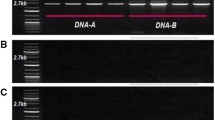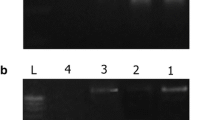Abstract
Mungbean yellow mosaic Indian virus (MYMIV) and bruchid infestation are severe production constraints of mungbean in South Asia, a major global mungbean production area. Marker-assisted selection for resistance against these disorders while maintaining or even improving agronomic traits is an important step toward breeding elite mungbean varieties. This study employed recombinant inbred lines (F12) derived from a cross between MYMIV-tolerant Vigna radiata NM92 and bruchid-resistant V. radiata ssp. sublobata TC1966 to identify chromosomal locations associated with disease and insect pest resistance and seed traits. A linkage map comprising 11 linkage groups was constructed with random amplified polymorphic DNA (RAPD), sequence characterized amplified regions (SCAR), cleaved amplified polymorphic DNA (CAP), amplified fragment length polymorphism (AFLP) and simple sequence repeat (SSR) markers. Quantitative trait loci (QTLs) for MYMIV and bruchid resistance, 100 seed weight and seed germination rate were identified. Three major QTLs for MYMIV and one major bruchid resistance locus were mapped on LG 9. The resistance alleles were contributed by the MYMIV tolerant parent NM92 and the bruchid resistant parent TC1966 respectively. One of the MYMIV QTLs was tightly linked in repulsion phase to the bruchid resistance locus. In addition, three minor QTLs for MYMIV resistance were found, where the resistance alleles were contributed by TC1966. Lines combining MYMV resistance alleles from both parents have greater resistance to MYMIV than the tolerant parent. Two minor bruchid resistance QTLs were identified in TC1966. Furthermore, three QTLs each for 100 seed weight and germination rate were detected. The markers defining the QTLs identified in this study will be useful in marker-assisted breeding of improved mungbean varieties in the future.




Similar content being viewed by others
References
Akhtar KP, Sarwar G, Abbas G, Asghar MJ, Sarwar N, Shah TM (2011) Screening of mungbean germplasm against mungbean yellow mosaic India virus and its vector Bemisia tabaci. Crop Prot 30:1202–1209
Ali MZ, Khan MAA, Karim MM, Ahmed M, Ahmed F (2010) Field performance of some mungbean varieties against mungbean yellow mosaic virus and Cercospora leaf spot diseases. J Exp Biosci 1:11–16
AVRDC (1995) A mungbean for south Asia. Centerpoint 13:8–9. AVRDC, Tainan
Bains K, Yang RY, Shanmugasundaram S (2003) High iron mungbean recipes for north India. AVRDC-The World Vegetable Center. AVRDC publication, Tainan, 03–562.34. p. 3
Banto SM, Sanchez FF (1972) The biology and chemical control of Callosobruchus chinensis (L.) (Coleoptera: Bruchidae). Phil Ento 2:167–182
Bashir M, Ahmad Z, Mansoor S (2006) Occurrence and distribution of viral diseases of mungbean and mashbean in Punjab, Pakistan. Pak J Bot 38:1341–1351
Chen KC, Lin CY, Kuan CC, Sung HY, Chen CS (2002) A novel defensin encoded by a mungbean cDNA exhibits insecticidal activity against bruchid. Journal of agricultural and food chemistry 50:7258–7263
Chen HM, Liu CA, Kuo CG, Chien CM, Sun HC, Huang CC, Lin YC, Ku HM (2007) Development of a molecular marker for a bruchid (Callosobruchus chinensis L.) resistance gene in mungbean. Euphytica 157:113–122
Dhole VJ, Reddy K (2012) Genetic analysis of resistance to mungbean yellow mosaic virus in mungbean (Vigna radiata). Plant Breeding 131:414–417
Diaz-Pendon JA, Truniger V, Nieto C, Garcia-Mas J, Bendahmane B, Aranda MA (2004) Advances in understanding recessive resistance to plant viruses. Mol Plant Pathol 5:223–233
Graham PH, Vance CP (2003) Legumes: importance and constraints to greater use. Plant Physiol 131:872–877
Green SK, Kim DH (1992) Mungbean yellow mosaic disease: Proceedings of an international workshop, Bangkok, Thailand. 2–3 July 1991. AVRDC Publication No. 92–373, Tainan, p 79
Humphry ME, Konduri V, Lambrides CJ, Magner T, McIntyre CL, Aiken EAB, Liu CJ (2002) Development of a mungbean (Vigna radiata) RFLP linkage map and its comparison with lablab (Lablab purpureus) reveals a high level of colinearity between the two genomes. TAG 105:160–166
Indian Institute of Pulses Research (IIPR) (2011) Vision 2030. Gupta S (ed.) Indian Institute of Pulses Research (ICAR), Kanpur, p. 42
Iqbal U, Iqbal SM, Afzal R, Jamal A, Farooq MA, Zahid A (2011) Screening of mungbean germplasm against mungbean yellow mosaic virus (MYMV) under field conditions. Pak J Phytopathol 23:48–51
Jacob SS, Vanitharani R, Karthikeyan AS, Chinchore Y, Thillaichidambaram P, Veluthambi K (2003) Mungbean yellow mosaic virus-Vi agroinfection by codelivery of DNA A and DNA B from one Agrobacterium strain. Plant Dis 87:247–251
Joehanes R, Nelson JC (2008) QGene 4.0, an extensible Java QTL-analysis platform. Bioinformatics 24:2788–2789
Kaga A, Ishimoto M (1998) Genetic localization of a bruchid resistance gene and its relationship to insecticidal cyclopeptide alkaloids, the vignatic acids in mungbean (V. radiata L. Wilczek). Mol Gen Genet 258:378–384
Khattak GSS, Haq MA, Ashraf M, Elahi T (2000) Genetics of mungbean yellow mosaic virus (MYMV) in mungbean (Vigna radiata (L.) Wilczek). J Genet Breed 54:237–243
Khattak GSS, Iqbal S, Shah SA (2008) Breeding high yielding and disease resistant mungbean (Vigna radiata (L.) Wilczek) genotypes. Pak J Bot 40:1411–1417
Kitamura K, Ishimoto M, Sawa M (1988) Inheritance of resistance to infestation with azuki bean weevil in Vigna sublobata and successful incorporation to V. radiata. Jpn J Breed 38:459–464
Kosambi DD (1944) The estimation of map distances from recombination value. Ann Eugen 12:172–175
Maiti S, Basak J, Kundagrami S, Kundu A, Pal A (2011) Molecular marker-assisted genoty** of mungbean yellow mosaic India virus resistant germplasms of mungbean and urdbean. Mol Biotechnol 47:95–104
Malik IA (1991) Breeding for resistance to MYMV and its vector in Pakistan. In: Green SK, Kim D (eds.) Mungbean yellow mosaic disease: Proceedings of an International Workshop, Bangkok, Thailand. 2–3 July, 1991. AVRDC, Tainan, p. 79
Mei L, Cheng XZ, Wang SH, Wang LX, Liu CY, Sun L, Xu N, Humphry ME, Lambrides CJ, Li HB, Liu CJ (2009) Relationship between bruchid resistance and seed mass in mungbean based on QTL analysis. Genome 52:589–596
Menancio-Hautea D, Kumar L, Danesh D, Young ND (1993) A genome map for mungbean [Vigna radiata (L.) Wilczek] based on DNA genetic markers (2n = 2x = 22) In: O’Brien JS (ed) Genetic maps 1992. A compilation of linkage and restriction maps of genetically studied organisms. Cold Spring Harbor Laboratory Press, Cold Spring Harbor, NY, pp. 6.259–6.261
Nair RM, Schafleitner R, Kenyon L, Srinivasan R, Easdown W, Ebert A, Hanson P (2012) Genetic improvement of mungbean productivity. Proceedings of the 12th SABRAO Congress on Plant Breeding towards 2025: Challenges in a Rapidly Changing World, 13–18 January 2012, Chiang Mai, pp. 27–28
Nariani TK (1960) Yellow mosaic of mung (Phaseolus aureus L.). Indian Phytopathol 13:24–29
Parida A, Raina SN, Narayan RKJ (1990) Quantitative DNA variation between and within chromosome complements of Vigna species (Fabaceae). Genetica 82:125–133
Poehlman JM (1991) Climatic requirements. In: The Mungbean, Oxford and IBH Publishing, New Delhi, pp. 24–50
Selvi R, Muthiah AR, Manivannan N (2006) Tagging of RAPD marker for MYMV resistance in mungbean (Vigna radiata (L.) Wilczek). Asian J Plant Sci 5:277–280
Shad N, Mughal SM, Farooq K, Bashir M (2006) Evaluation of mungbean germplasm for resistance against mungbean yellow mosaic begomovirus. Pak J Bot 38:449–457
Shivaprasad PV, Thomas M, Balamani V, Biswas D, Vanitharani R, Karthikeyan AS, Veluthambi K (2006) Factors contributing to deletion within mungbean yellow mosaic virus partial dimers in binary vectors used for agroinoculation. J Virol Methods 137:72–81
Singh G, Sharma YR, Kaur L (1992) Methods of rating yellow mosaic virus of mungbean and urdbean. Plant Dis Res 7:1–6
Somta P, Seehalak W, Srinives P (2009) Development, characterization and cross-species amplification of mungbean (Vigna radiata) genic microsatellite markers. Conserv Genet 10:1939–1943
Sriphadet S, Lambrides CJ, Srinives P (2007) Inheritance of agronomic traits and their interrelationship in mungbean (Vigna radiata (L.) Wilczek). J Crop Sci Biotechnol 10:249–256
Tangphatsornruang S, Somta P, Uthaipaisanwong P, Chanprasert J, Sangsrakru D, Seehalak W, Sommanas W, Tragoonrung S, Srinives P (2009) Characterization of microsatellites and gene contents from genome shotgun sequences of mungbean (Vigna radiata (L.) Wilczek). BMC Plant Biol 9:137
Van Ooijen JW (2006) JoinMap 4.0 Software for the calculation of genetic linkage maps in experimental populations. Kyazma BV, Wageningen
Vos P, Hogers R, Bleeker M, Reijans M, van de Lee T, Hornes M, Frijters A, Pot J, Peleman J, Kuiper M, Zabeau M (1995) AFLP: a new technique for DNA fingerprinting. Nucl Acids Res 23:4407–4414
Weinberger K (2005) Assessment of the nutritional impact of agricultural research: the case of mungbean in Pakistan. Food Nutr Bull 26:287–294
Wu MF (2001) Expression profile analysis of Hsc70 of Vigna radiata; Master’s Thesis. National Tsin Hua University, Hsinchu
Yaqub M, Mahmood T, Akhtar M, Iqbal MM, Ali S (2010) Introduction of mungbean [Vigna radiata (L.) Wilczek] as a grain legume in the annual rice-wheat double crop** system. Pak J Bot 42:3125–3135
Acknowledgments
This study was funded by the Council of Agriculture, Taiwan, during 2003–2006. The authors thank Dr. NS Talekar for his support in performing the bruchid resistance assay and Ms. DR Ledesma for statistical assistance.
Author information
Authors and Affiliations
Corresponding author
Rights and permissions
About this article
Cite this article
Chen, HM., Ku, HM., Schafleitner, R. et al. The major quantitative trait locus for mungbean yellow mosaic Indian virus resistance is tightly linked in repulsion phase to the major bruchid resistance locus in a cross between mungbean [Vigna radiata (L.) Wilczek] and its wild relative Vigna radiata ssp. sublobata . Euphytica 192, 205–216 (2013). https://doi.org/10.1007/s10681-012-0831-9
Received:
Accepted:
Published:
Issue Date:
DOI: https://doi.org/10.1007/s10681-012-0831-9




